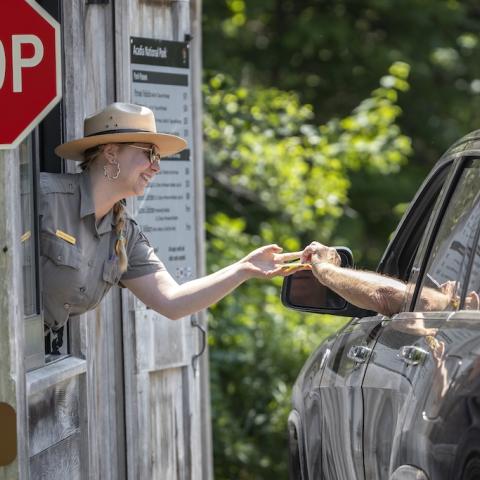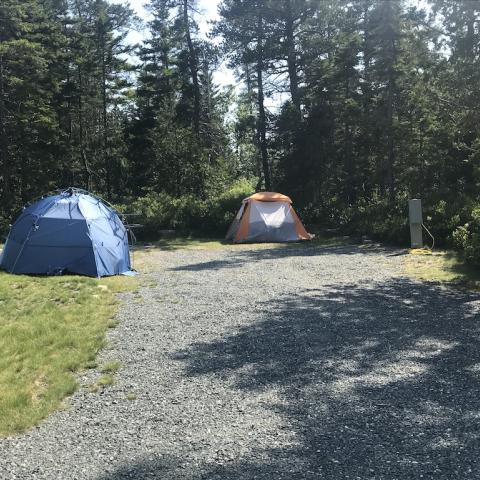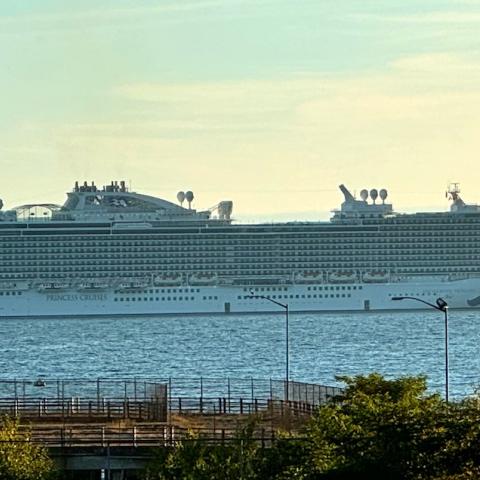
Acadia National Park officials have settled on a timed-entry reservation system to help reduce congestion in their coastal Maine park/NPS file
A "timed-entry" reservation system, one that would give visitors a specific window to enter Acadia National Park in Maine, is being proposed by the National Park Service as a solution to the heavy congestion that clogs Acadia in summer.
The plan, years in development and expected to take years to fully implement, also calls for the eventual phaseout of right-lane parking along the Park Loop Road; construction of a parking lot at a Park Service maintenance yard known as Liscomb Pit; additional parking at Hulls Cove next to the park's visitor center, which would be relocated on site, and; removal of visitor services at the Thompson Island Information Center on the west side of State Route 3, with that area to be restored to natural conditions.
"We believe the preferred alternative as revised in response to public comment best fulfills the purpose and need for the plan and the mission of the National Park Service," Acadia Superintendent Kevin Schneider said Monday. "The preferred alternative provides for the best protection of the significant natural and cultural resources of Acadia National Park while also providing high-quality experiences to visitors. This plan is a blueprint for the future; many of the details related to implementation of the Final Plan/EIS will take years and continue to require public feedback and stakeholder engagement.”
Like many national parks across the country, visitors flock to Acadia in ever-growing crowds, at some times diminishing the experience due to congestion on roadways and crowds at popular sites in the park. The transportation plan Acadia officials are proposing seeks to find a middle ground.
Elsewhere in the National Park System, both Arches and Zion national parks in Utah are working on their own crowd-management plans, and Yellowstone National Park officials in Wyoming in 2017 opened a nearly 1-acre gravel parking area near the Fairy Falls Trail in a bid to reduce illegal parking along the road shoulders. Yosemite National Park staff in California not only have worked to improve parking in the Yosemite Valley, but has experimented with an approach to pace and send vehicles to the Arch Rock Entrance Station.
At Acadia, the Final Transportation Plan Environmental Impact Statement released Monday said the timed-entry reservation system would "initially be implemented incrementally for the Ocean Drive corridor, Cadillac Summit Road, and the Jordan Pond North Lot during peak season (from mid-June to mid-October). During initial implementation of the plan, all other Acadia parking lots would continue to be managed on a first-come, first-served basis."
The proposal, sent to the Park Service's Northeast Regional director for approval, would allow visitors to spend as much time in the park once they entered Acadia. It also acknowledges some tinkering could be required as the plan is implemented.
"The length of the initial entry window may be lengthened or shortened as park managers optimize the reservation system; however, it is estimated that initial timed-entry windows would be in 15-minute to 2-hour time blocks," the EIS said.
It is expected that the reservation system would kick in during the second Friday in June and end the Sunday after Columbus Day, though that window could be stretched or reduced to reflect traffic patterns. Reservations would be required as early as 4 a.m. for visitors wanting to drive to the summit of Cadillac Mountain, and as late as 5 p.m. at the Jordan Pond north lot and along the Ocean Drive corridor, the EIS said.
Park staff estimate that the reservation system could handle 1,460 vehicles per day for Cadillac Mountain, 850 cars for the north lot at Jordan Pond House, and 1,020 vehicles along the Ocean Drive corridor.
If traffic monitoring elsewhere in the park noted congestion problems that were impacting park resources, "access to Island Explorer routes entering the park, vehicle access to other parking lots, or vehicle access to the entire Park Loop Road may be added to the reservation system."
However, park staff also said that expanding the reservation system for the entire Park Loop Road would require "reconfiguring some existing park entrances to be exits only, constructing new or relocating existing entrance stations, and potentially making the entire Park Loop Road one way."
The EIS notes that it long has been the Park Service's intent to end right-lane parking along the Ocean Drive corridor to "restore a driving experience that more closely resembles the road's original design intent and to improve safety by providing an additional travel lane for bicyclists and slow-moving vehicles."




 Support Essential Coverage of Essential Places
Support Essential Coverage of Essential Places







Comments
How about we limit access for non-US visitors during peak days/times? American citizens' taxes go to pay for the parks, we should get access before busloads of foreign tourists. I have no issue with people from outside the country visiting, but something has to be done about the congestion at parks like Acadia, Yosemite, RMNP, and Yellowstone and taxpayers should get priority during peak times.
I agree. Last time we went could not get in because so many buses of non Americans.
Make their buses and groups should on be a certain number.
I wonder if you both treat guests to your home in the same ugly fashion because that is what they are, guests in our country and should be treated as such. You pay a minuscule amount in taxes to support the parks. Many foreign visitors are here for a limited time, a week, two weeks and hope to see as much as they can in that short time. Sad to see these comments.
The one good thing about this reservation system is the certainty of what the visit to the park would be like as far as crowds. if they are limiting visitation, then each visitor's experience would likely be optimized.
First of all, I vote against xenophobia. People just love to blame immigrants or visitors for everything. Enough Of that.
Second, I vote for Ed Abbey's idea of making the national parks primarily foot and bicycle focused. Keep the roads where they are, but use them only for park busses to shuttle around the people that can't get around on foot or cycle. It would reduce congestion, pollution, and damage from too many people in the parks. I respectfully disagree with those that value access over conservation.
Sean, while I don't agree with banning non-US visitors, there is nothing xenophobic about the comments nor is anyone assessing "blame" on immigrants or visitors. Words like xenophobic and racisists have been so miss used in recent years they risk losing their real meaning and true negative context. These folks don't fear or hate foreigners, they just feel (unjustifiably) they have already paid for the parks so they should have first dibs. As to making the parks primarily foot and bicycle, that might work in a few parks but I suspect under those circumstances, parks like Arches would be empty in July and I doubt many want to walk or bike from Grant Village to Old Faithful in Yellowstone.
During Abbey's time I believe horseback was the preferred method of transport. I remember the scene from Indiana Jones and the Last Crusade where Indy's Boy Scout group was riding through the then Arches National Monument on horseback - passing by Balanced Rock.
As for the rest of the discussion, the one word I would use to describe it is "facile". It's overly simplifying the problem to one that can be solved by something that seems simple. But of course it's going to create a whole lot of different problems such as identifying who is or isn't eligible to enter. The real problem we have is summer vacation. An ideal situation would spread out visitation to spring and fall, but summer is when kids are off from school.
Yes on xenophobia. What has gotten into this country. I also agree about Abbey's idea for restricting access. Visitation now is way beyond what it was in Abbey's time, most of it by Americans by the way. If the park service is to meet its dual mission it has to restrict access by private vehicle and help those who cannot walk or bike.